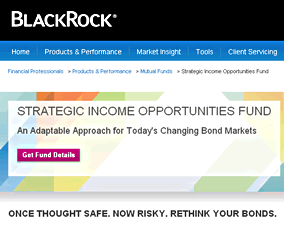New York-based investment manager, BlackRock Investments, LLC, started running a full- and half-page color ads in the Wall Street Journal.
The attention-grabbing ad headline, in large bold letters, that “Traditional Bond Funds You Once Considered Safe Investments May Not Be So Safe Anymore” must have been a bit unnerving to some bond investors.

The advertisements’ questionable message, accompanied by an equally dubious fund recommendation [see below], remained the same in all the ads. The tone and magnitude of this sales pitch struck me as a clear victory for BlackRock’s marketing department over common sense investing.
These days, an expected rise in interest rates and/or inflation are legitimate concerns for bond investors’ portfolio values. However, most investment professionals agree that it would be misleading to classify investment grade bonds, with reasonable durations [interest rate sensitivity], as unsafe for bond investors with a long-term investment horizon. To imply that such holdings are undue risks strikes me as misleading.
Adding insult to injury, the ad narrative contains a recommendation for BlackRock’s Strategic Income Opportunities Fund [BASIX] as an alternative to “traditional” bond funds. According to BlackRock, the latter are described as “Once Safe. Now Risky.” On the other hand, the BASIX fund is defined as an “all-weather approach” [nontraditional bond fund category] that can “move freely in search of the best income opportunities.”
As is usual with most mutual fund recommendations, the devil is in the detail, which prompted me to take a look at the investment qualities of the BlackRock Strategic Income Opportunities Fund.
Here’s what I discovered:
- The Fund’s average portfolio credit-quality is in the risky “junk bond” classification [BB]. Morningstar’s take on nontraditional funds like BASIX is that “… investors should be cautious about how much and just what kind of risks these bond funds funds are taking.”
- BASIX’s costs and expenses run on the high side. It has a front-end sales-charge of 4.0% and an expense ratio of 0.90%, both of which, unfortunately, are fairly typical for so-called nontraditional bond funds. What is of concern is the Fund’s annual, off-the-charts, portfolio turnover rate of 800%. Can you imagine the BASIX’s transaction costs? Remember, this expense is not included in a mutual fund’s expense ratio. Similar type and size funds, such as Driehaus LCMAX and PIMCO PFIAX, have annual portfolio turnover rates in the 40% range.
- BASIX only has a 5-year track record. Its annual average total return for this period is 5.78%; the same metric for the Fund’s benchmark, the Barclays Capital US Aggregate Bond Index is 5.72%. It’s no surprise then that Morningstar ranks BASIX 38th in its fund peer category of 38 funds for 5-year total return.
Suffice it to say that, in spite of massive advertising support, these not-so-positive investment-quality indicators suggest that BASIX would be a questionable alternative to what BlackRock considers to be traditional bond funds.
Richard Loth is the founder and publisher of the Fund Investor’s Schoolhouse, a mutual fund investing educational platform for individual investors (www.fundschoolhouse.org).
